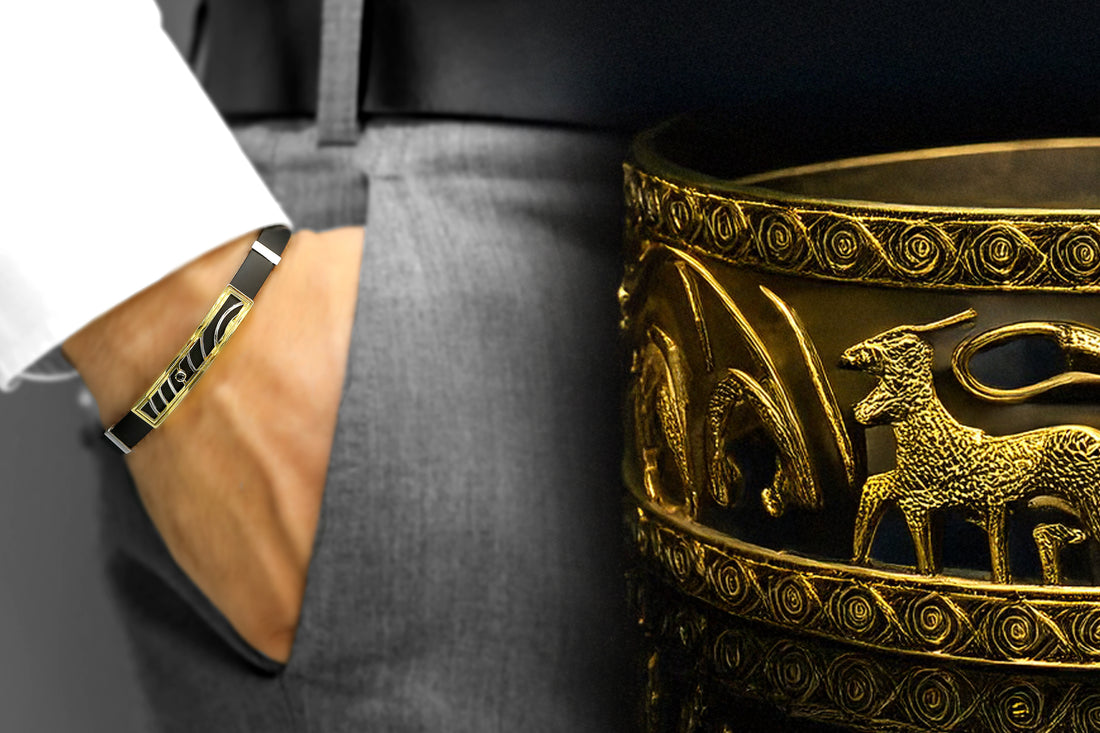
The Evolution of Men's Gold Jewellery
Share
Gold jewelry has been a symbol of wealth, status, and style for centuries, and men have worn it as a means of expressing power and individuality throughout history. The evolution of men’s gold jewelry reflects changing social norms, artistic movements, and technological advancements. Let’s take a look at the key trends in men’s gold jewelry through the ages and what the future might hold.
- Ancient Civilizations: Symbols of Power
In ancient Egypt, Greece, and Rome, gold jewelry was worn by men to signify status and power. Egyptian pharaohs adorned themselves with intricate gold pieces such as collars, rings, and bracelets, often featuring symbols of the gods or protective amulets. The Greeks and Romans continued this tradition, with signet rings and coin necklaces becoming popular among men of high rank.
- The Middle Ages: Religious and Royal Influence
During the Middle Ages, men's gold jewelry often had a religious significance. Rings and crosses were worn by the clergy and nobility, symbolizing both faith and authority. Royalty continued to wear extravagant gold chains, brooches, and crowns. Gold was associated with wealth, and men of power used it to distinguish themselves from the common people.
- The Renaissance: Luxury and Individuality
The Renaissance period saw a revival of opulence, and men began to wear more elaborate gold jewelry. Gold rings, necklaces, and pendants became popular accessories for the affluent, often featuring gemstones and detailed engravings. The Renaissance was a time when personal style and individuality began to emerge, and men used jewelry as a form of self-expression.
- The 18th and 19th Centuries: Masculine Elegance
During the 18th and 19th centuries, men's fashion took on a more refined and elegant tone, and gold jewelry played a role in this transformation. Men wore pocket watches, cufflinks, and rings as symbols of sophistication. The Victorian era, in particular, was known for ornate and sentimental jewelry, with mourning rings and lockets becoming popular among men.
- The 20th Century: Statement Pieces and Cultural Influence
The 20th century was a time of radical change in men’s jewelry fashion. The roaring twenties saw men embracing bold, statement-making jewelry, including chunky gold chains and tie bars. The influence of hip-hop culture in the 1980s and 1990s brought gold chains, grills, and oversized rings into mainstream fashion. These bold accessories became a way for men to express power, wealth, and individuality.
- The Modern Era: Minimalism and Tech-Inspired Designs
Today, men’s gold jewelry trends have moved towards minimalism and subtle sophistication. Sleek gold rings, bracelets, and necklaces with clean lines are now popular choices, often favored by those who appreciate fine craftsmanship and understated elegance. At the same time, technology has influenced design, with some pieces featuring innovative elements, such as smart jewelry that integrates with digital devices.
- The Future of Men's Gold Jewelry
Looking ahead, we can expect to see a blend of traditional craftsmanship with modern aesthetics. Gold jewelry for men may become even more customizable, with advancements in 3D printing and design allowing for personalized, unique pieces. Additionally, sustainability will play a larger role, as consumers seek ethically sourced and environmentally friendly materials. The influence of streetwear culture and tech innovations, such as smart jewelry, will likely continue to shape the future of men’s gold jewelry fashion.
Conclusion
From ancient kings to modern trendsetters, men’s gold jewelry has always been a reflection of personal style, power, and status. As fashion continues to evolve, gold jewelry will remain a timeless symbol of elegance, blending history with contemporary design to offer something for every man’s taste. Whether opting for a minimalist look or a bold statement piece, the future of men’s gold jewelry is bright, innovative, and full of possibilities.
